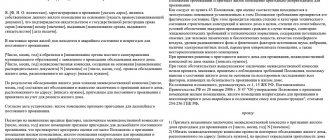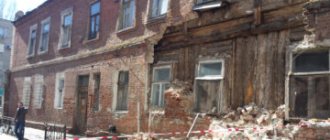What is the resettlement program?
Even the most reliable housing becomes unusable over time. To resolve the issue of providing citizens with comfortable living conditions, a special program financed from the budget has been created. As part of the program, a list of houses for resettlement is established, as well as a list of replacement housing. Resettlement activities have been carried out within the framework of the program since 2002.
The law on relocation from emergency housing is constantly changing. As of 2020, the order remains the same. Interdepartmental municipal commissions make decisions only if they have the expertise of an independent organization.
The regional resettlement program is approved by the executive body of local government. Particular attention is paid to the timing of the procedure and the level of accidents of buildings. The program includes a list of houses recognized before January 1, 2012 as dangerous to live in and subject to demolition. The document also reflects the amount of funding aimed at resettlement and the provision of new living space. Regional authorities are required to justify the amount of funds allocated to the program and establish indicators for assessing the results of the work.
What decision can be made?
Now we need to consider how local authorities might react. An apartment building in disrepair is a rather loose concept, and therefore decisions regarding its restoration may vary. It all depends on the degree of wear and tear of the structure:
- The premises have minor damage that does not pose a danger to human health or life. It complies with sanitary and hygienic requirements and other standards established by law. Such damage can be eliminated after thorough repairs. In this case, serious restoration of the structure is not required.
- The building has serious damage that can be eliminated through redevelopment, major repairs or reconstructive actions. Such restoration requires serious financial investments, so the commission must determine the feasibility of strengthening the buildings.
- The building does not meet the established requirements and is unsuitable for further habitation. At the same time, it is no longer possible to somehow correct the situation.
- Due to the influence of certain factors, a dilapidated residential building cannot be suitable for living and must be demolished. It must be carried out so that the falling structure does not damage neighboring buildings.
Whatever decision is made, it must be as informed as possible. The fact is that the procedure requires the execution of certain documents, and is also associated with difficulties in relocating families. However, this issue must be considered separately.
Provisions of the resettlement program
The legislative provisions of the program are enshrined in the Federal Law “On the Fund for Assistance to the Reform of Housing and Communal Services” No. 185 FZ of July 21, 2007. The law reflects the general provisions, the operating procedure of the Fund and the specifics of providing financial assistance. The Housing Code of the Russian Federation will also help resolve the controversial situation.
Dilapidated and unsafe houses are subject to resettlement. A house belonging to the Housing Fund of the Russian Federation is recognized as unsafe in accordance with Government Decree No. 47 of February 28, 2006. Private buildings are classified as unsafe after the conclusion of a special commission and notification of the owner.
Such houses include:
- There are no water supply, electricity or heating systems. This rule does not apply to houses consisting of 1 or 2 floors, since they may not have sewerage or running water;
- the house is located in an area of possible flooding, avalanches or landslides;
- the permissible level of noise, electromagnetic field and chemicals harmful to humans has been exceeded;
- the supporting structures are deformed to a degree that threatens the collapse of the building;
- The wear and tear of stone buildings is 70%, and that of wooden buildings is 65%. In this case, the housing is considered dilapidated and is also subject to resettlement and demolition;
- The garbage chute cleaning device is located above the room inside the house. Such a structure is considered unsuitable for habitation;
- a fire, accident or other emergency caused major damage to the building;
- The floor level of the first floor is below the ground level of the plan.
The lack of an elevator in buildings with a height of 5 floors or less does not apply to the deterioration of living conditions.
If 2/3 of the premises of the house are considered uninhabitable for one of the listed reasons, the structure is considered unsafe.
Residents of the emergency building are provided with new houses or apartments. A relocation contract may be concluded for this purpose.
The agreement is concluded with the owner of the property in the house subject to demolition or reconstruction. In general, a preliminary agreement for relocation can be concluded. The document contains provisions:
- term for concluding the main contract;
- type of compensation (cash or in kind);
- information about family members who have the right to live with the owner;
- relocation procedure;
- form of the main agreement.
The preliminary agreement is registered with the Department. Under the main agreement, other comfortable housing is provided on the basis of an exchange agreement, or another agreement implying the acquisition of ownership rights. Living space can also be transferred under a social tenancy agreement. Another compensation option is a monetary amount that includes the cost of housing and relocation costs. In this case, the value of the property is determined by an independent appraiser.
How and where can you find out the list of houses for resettlement?
The list of houses subject to resettlement is approved by the local administration of the subject. The priority depends on the degree of damage to the house and its age.
In order to obtain information about including your home on the list, you must go to the website of the Russian Ministry of Construction https://www.minstroyrf.ru/. In the “Activity” list, select “Housing and communal services”. Next, select the item “Liquidation of emergency housing”. At this stage, you can download the document “Strategy for the Development of Housing and Communal Services” for review. By clicking “More details” in the “Liquidation of emergency housing” section, the page is viewed to the end and “Relocation of citizens from emergency housing” is selected. Next, the website “Housing and Communal Services Reform” opens. On the page that opens, you can sort houses by the date they were recognized as unsafe (before 01/01/2012 or later) in the “Emergency Housing Stock” section. By selecting a federal subject, you can obtain the following information:
- data on completed resettlement;
- a list of houses in need of liquidation;
- volume of settlement by year;
- relocation analytics.
By selecting a specific area or city, you can see a list of emergency buildings indicating the street and house number. The actual area for resettlement, the year of planned or actual resettlement, and the number of contracts concluded are also indicated. One of the symbols can be indicated next to the address:
- question mark - there is no data on the living space in the house, there is no end date for resettlement, the total area of resettlement under the contract is larger than the specified area for resettlement under the program;
- Libra - relocation is hampered by unforeseen circumstances (court proceedings, entry into inheritance rights and other circumstances related to the owner);
- tick - resettlement is completed.
The absence of a necessary house on the list indicates its absence in the list of the state resettlement program.
How will the move be carried out?
According to the mayor’s office, if the planned work is completed on time, then in the fall of 2021 the first residents of Moscow will be offered options for relocating from Khrushchev-era buildings. And work on the demolition and relocation of residents of the five-story buildings will begin in 2021. The federal renovation law states that residents will have 60 days to consider the proposal. Each case of refusal to participate in resettlement will be considered in court. The decision made will take effect immediately. It will be possible to challenge in court not the recognition of a private house itself as unsafe and subject to demolition, but the apartment provided.
The construction of apartment buildings is carried out according to city orders. If there are available apartments in the housing stock, those moving will be offered several options to choose from. Those Muscovites who will continue to move under the Luzhkov program will be given a choice of three apartment options.
Demolition of Khrushchev buildings
As a rule, in the housing provided, the area of auxiliary premises will be significantly larger. Those standing in line to receive an apartment will receive housing in accordance with social standards (18 square meters per person).
What documents are needed to recognize a house as unsafe?
If the house is not on the list of the resettlement program, residents can independently initiate distribution to new houses. To do this you will need a package of documents:
- an application in the prescribed form from a resident or group of residents;
- technical plan of the house, containing information on the degree of deterioration of structures and the residual value of the building;
- certificate of repair work and inspections of premises over the past 3 years;
- conclusion of sanitary-epidemiological, fire and other services;
- a conclusion on the technical condition of housing provided by a licensed design and survey organization;
- technical plans of premises;
- written complaints from owners.
Depending on the situation, other documents may be required. After submitting an application, the authorized body considers it within 5 days. After accepting and studying the documents, a special commission is created, which includes representatives of the authorities, special services and residents of the house. The commission examines the actual condition of the house and makes a decision on the need for liquidation, reconstruction or major repairs of the building.
Reconstruction means changing the technical characteristics of a building in order to replenish characteristics lost during the process of wear and tear. Reconstruction and major repairs extend the life of a building, making it suitable for habitation.
The decision to demolish the house is implemented no later than 1 year after the relevant conclusion.
List of recognized emergency
If the decision to assign emergency status was made at the request of the owners of the house, then they can find out information about the assignment of their property to a certain emergency status from the official response to the submitted application.
In the event that a decision to recognize a house as unsafe is made on the basis of the conclusion of an interdepartmental commission held in connection with the adoption of a state or municipal program, then information that a certain housing stock is classified as unsafe is disseminated through the media and in accordance with the law, for a year before demolition.
Also, information about whether a house is recognized as unsafe can be obtained by using information about the condition of the house through local Internet portals, which contain a register of unsafe houses or a list of buildings recognized as unsafe.
IMPORTANT! If information is missing, you can contact local municipal authorities in writing.
What is the procedure for moving out of dilapidated housing?
The actual resettlement of residents occurs after all the nuances have been clarified. If a decision is made to demolish a house in disrepair, the owners receive notification within 5 days. The timing of the procedure depends on the likelihood of the building collapsing and the complexity of the situation as a whole. Residents of a house included in the resettlement program wait for new living space on a first-come, first-served basis. The distribution of house residents within the program cannot exceed the period specified in the document.
If the residents are not satisfied with the decision of the commission, an interdepartmental commission can be involved to assess the condition of the house. In case of insurmountable contradictions, it is worth going to court.
The owner of the apartment has the right to receive real estate that is not inferior in technical characteristics and degree of comfort to the previous place of residence. If all program conditions are met, housing must be provided in the same area. By agreement with the apartment owner, this condition can be changed.
In Art. 57 of the Housing Code of the Russian Federation it is noted that resettlement from dilapidated housing is not an event to improve living conditions, but refers to forced measures. This allows the administration to force eviction.
Persons living in the dormitory must receive similar living space after resettlement, that is, the occupied area and number of rooms must be maintained.
If the owner decides to choose monetary compensation for the purchase of a new home, the amount includes:
- property value;
- costs of finding a suitable option;
- expenses for paperwork;
- moving costs.
If the owner does not agree with the proposed amount, the amount of compensation may be determined by a court decision.
When moving from an apartment, the number of rooms is not maintained. In a new house, only the total area of the previous apartment is taken into account, which may slightly worsen living conditions.
Communal apartments and private housing
Owners of communal apartments also have the right to resettlement. If the owner signed a social rental agreement for the premises, then his relocation is compensatory in nature. He will definitely receive equivalent housing. As for private property, the authorities have the right not to provide another apartment, but are obliged to pay its redemption price. It should be noted that housing can be issued in any area of the city. Everything depends on the capabilities and reserves of government agencies.
Thus, relocation from dilapidated buildings is most often carried out when these buildings are included in the targeted program. Otherwise, monetary payments to the victim are provided.
Nuances and tips
Most of the new living space provided to resettlers is located in new houses. Before moving, you should make sure that all communications are working properly.
Residents must be relocated to housing located within the city. If you plan to move to the suburbs, you can file a complaint with the authorized body. If desired and possible, the owner may agree to move to another locality.
If you agree with the proposed option, moving costs will be reimbursed by the municipality.









